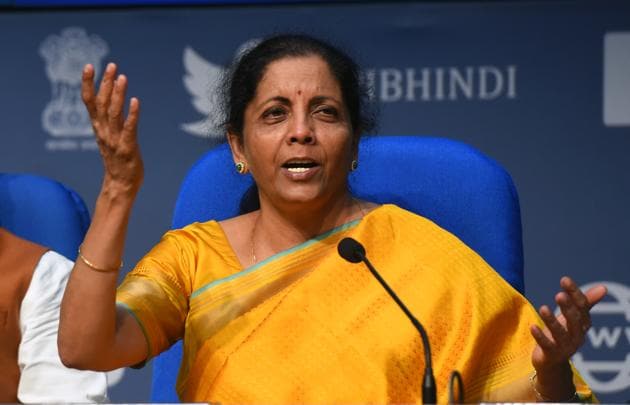February 14, 2020
A careful analysis of data disproves the claim that 70% taxpayers will benefit from the dual system

Eighty per cent of income tax filers will not be impacted by the new structure and another 15% will not see any significant savings benefits(Mohd Zakir/HT PHOTO)
By
Praveen Chakravarty
In the Union Budget, finance minister Nirmala Sitharaman, with great flourish, announced a new personal income tax structure. This was touted as yet another “significant reform” that would simplify the income tax regime.
Currently, there are three tax income tax rate slabs, there will be six in the new structure. There are exemptions for savings and home loans, there will be none in the new structure, in lieu of reduced income tax rates. There is one income tax framework now. Going forward, there will be an option between the old and the new structure. Sitharaman claimed that this ‘new and simplified’ personal income tax regime will bring ‘substantial benefit’ to a ‘vast number of middle-class Indians’.
Predictably, the media latched on to this as the most important announcement in the budget. After days of ceaseless commentary and analysis, questions were raised — is this new income tax structure actually beneficial to the working class, will it be possible to switch from one structure to another every year, does one need to forego all exemptions to avail of the lower tax rate, will this impact home ownership and so on.
Subsequently, the revenue secretary of the finance ministry, in an interview, sought to clarify. He claimed that “the Finance Ministry has analysed income tax data of 58 million people and that 70% of taxpayers will benefit from this new income tax structure”. Ms.Sitharaman has also touted publicly that a ‘vast number of taxpayers’ will benefit from this new tax structure. While the finance minister and her officials have greater access to better information and data than most others, the claim that 70% of people will benefit from the new income tax structure sounds suspect and misleading.
As per income tax data made publicly available for the assessment year 2018-19, there were 55 million (5.5 crores) individuals who filed an income tax return. The income tax department has made available aggregate data of gross income, different types of income, ‘returned income’ and actual income tax paid by these 55 million income tax filers in 2018-19. Returned income refers to the income that will be used for tax computation after availing tax exemptions. This data can be analysed to estimate how many income tax filers have taken benefits of the income tax exemptions and by how much. Using this, it is possible to infer how many people will be impacted by the new income tax structure.
Individuals that earn less than five lakh rupees a year will be exempt from income tax in both the old and the new regimes. Forty-one (75%) of the 55 million reported a returned income of less than five lakh rupees. In other words, 75% of income tax filers in 2018-19 were not required to pay any income tax, either with tax exemption benefits or without. Which then implies that 75% of income tax filers will not care about the ‘new and simplified’ income tax structure. It is then unclear how the finance minister and the revenue secretary made the startling claim that more than 70% will benefit from the new structure when data shows that 75% of them will not even be impacted by the new tax regime.
Next, for people earning more than Rs 15 lakh a year, there is no change in tax rates between the old and the new structure. Which means people in this income category will be ambivalent between the two structures since their tax rates do not change. As per the 2018-19 data, roughly 5% of all income tax filers reported gross income of more than Rs 15 lakhs a year and hence will not be bothered by the new tax structure.
So, in total 80% (75%+5%) of income tax filers of 2018-19 will not benefit from the new structure and will remain agnostic between the old and the new.
Of the remaining 20% of all income tax filers that could potentially be impacted by the new structure, nearly three-quarters of them paid an average amount of Rs 23,000 in income tax, after exemptions. For a person paying just Rs.23,000 annually in income tax, the new structure with a five or ten percentage point reduction in tax rates in lieu of foregoing exemptions will not generate any significant savings.
Hence, 80% of income tax filers will not be impacted by the new structure and another 15% will not see any significant savings benefits. That makes it 95% of all income tax filers of 2018-19. Which then means, as per this analysis, the new income tax structure will be of significant impact to just three million (5%) out of the total of fifty-five million income tax filers of 2018-19.
It is baffling that the finance minister and her Revenue Secretary claimed that more than 70% of income taxpayers will benefit from the new structure. Unless, they are indulging in word play between income tax “filers” and income tax “payers”. That is, they are perhaps referring only to the tiny fraction of people that pay substantial income tax, and claimed that 70% of this tiny fraction will benefit from the new structure. Which is obviously a misleading, mischievous and a hollow claim to grab headlines, a habitual practice of the current government.
Praveen Chakravarty is a political economist and a senior office bearer of the Congress
The views expressed are personal
